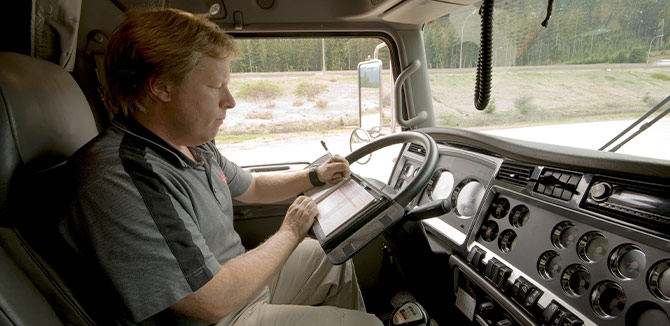
Electronic logging devices: Trends in Enforcement
It’s been over a year since the electronic logging device (ELD) mandate went into effect in December of 2017. While progress has been made on the ELD compliance front since then, the battle for complete ELD enforcement throughout the trucking industry rages on.
At the heart of the debate about electronic logging devices lies the belief that limiting the number of hours that truck drivers work will help reduce driver fatigue. Current Federal Motor Carrier Safety Administration (FMCSA) rules stipulate that during a 14-hour period, CDL drivers can spend no more than 11 hours driving.
As use of electronic logging devices becomes more strictly enforced, we spoke with Collin Mooney, executive director of the Commercial Vehicle Safety Alliance (CVSA), about emerging trends in ELD enforcement that the alliance observes. Here are the top three observations Mooney sees right now.
The transition from automatic on-board recording devices (AOBRDs) is in full swing.
Before electronic logging devices became mandated, some commercial motor carriers installed and required their drivers to use “grandfathered” automatic on-board recording devices. Several carriers already had purchased and were operating AOBRDs, so the FMCSA allowed them more time to work with their vendors and obtain the upgraded software needed to be compliant with the new ELD rule. Carriers can continue to use grandfathered AOBRDs only until Dec. 16, 2019, when they must be in compliance with the ELD mandate.
“The transition away from automatic on-board recording devices is the biggest thing happening related to electronic logging devices right now,” Mooney said. Some trucking fleets are making the switch to ELDs now; others will push it off even longer. Unlike electronic logging devices, which are attached to a truck’s engine control module (ECM) to show exactly when the truck is moving and how far it’s moving, automatic on-board recording devices aren’t attached to the ECM. And that allows for falsification, Mooney said. “Other than using supporting documentation to validate a driver’s hours of service, there’s no engine control module validation with an AOBRD,” he said.
Hours of service violations are at historic lows.
Before you get all excited about that, understand that those numbers are artificially low because the educational period is still in effect. The educational period is when DOT inspectors forego issuing drivers violations in favor of educating them on what’s required to better comply with ELD regulations.
While the educational period was set to end in April of 2018, officer discretion is part of it. And as the new ELD requirement is fully implemented, enforcement officers continue to educate drivers and carriers. Normal everyday CMV enforcement is conducted at weigh scales and inspection stations, special check stops and mobile patrols. In those locations, “inspectors work to extract information from the device itself, and that takes time,” Mooney said.
“It takes a long time to have those discussions and work through that process, so when the grandfathered automatic on-board recording devices do finally sunset, we’re going to see a gradual increase in hours of service and electronic logging device violations,” Mooney said. “It’s anticipated that some motor carriers won’t be in compliance by the December 2019 deadline, so they won’t be operating an electronic logging device when required. And because the extended educational period will be over, there will be less of a focus on educating drivers and thus, stricter enforcement.”
The FMCSA has been issuing several exemptions during the educational period.
“That’s contributing to an uneven playing field across the commercial transportation industry,” Mooney said.
Because of the unique challenges some carriers could face in having to stop for the day to meet hours of service requirements, carriers of certain types of freight (agricultural commodities, perishable goods and livestock, for example) have received exemptions. For these carriers, for example, they contend that it doesn’t make sense for a perishable goods or livestock carrier to stop for hours-of-service reasons in the dead of summer if it means their freight is going to be harmed from prolonged heat exposure.
But Mooney said offering exemptions can lead to confusion about which fleets must be in compliance and which aren’t required to be. “If confusion persists, there’s a chance that roadside inspections will become cumbersome and time consuming,” he said. “When exemptions are issued, it becomes harder for law enforcement to manage regulations consistently.”
Changes within the hours of service rules themselves, such as eliminating the 30-minute rest break requirement, could help lead to greater understanding and more uniform compliance, Mooney said.
Source:https://www.lytx.com
 I´m a Fleet Management expert, and the manager of Advanced Fleet Management Consulting, that provides Fleet Management Consultancy Services.
I´m a Fleet Management expert, and the manager of Advanced Fleet Management Consulting, that provides Fleet Management Consultancy Services.



